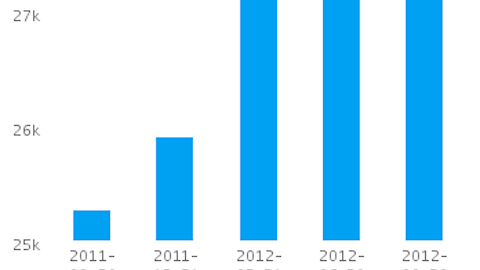At the 2012 Invest for Kids conference, Jim Grant – author of Grant’s Interest Rate Observer – shared his candid thoughts on the current state of interest rates. Jim’s overbearing thesis is that the bull market in bonds is soon to end, which will be a result of rising interest rates. Grant points out that “interest rates trend in generational life cycles…and there is muscle memory in the markets.” Given that rates have been in steady decline over the last 31 years it could be time for a reversal.
One of Grant’s general investing recommendations includes gold, where gold is currently in a bull market for the past 13 years and this trend should continue into the near future. This will be driven by the central bank’s policy and the fact that Obama won the presidential election, leaving Bernanke as the Fed chairman for at least another couple years. Check out our five stocks to buy as gold prices continue upward.
Grant’s top stock pick is the global life insurer Metlife Inc (NYSE:MET). Grant noted key Metlife stats that include $820 billion in assets, 90 million customers and a brand name that makes it one of the great life insurance agencies out there. Top investors in Metlife during 2Q were Relational Investors and Legg Mason Capital Management. Relational had over 4% of their 2Q 13F invested in Metlife, while Legg Mason had over 2% invested.
Grant praised Metlife’s management for forecasting the decline in interest rates. In 2004, MetLife bought derivatives to hedge against a drop in interest rates, a move that has made them upwards of $500 million. Then, thanks to the life insurer’s strong pocket book, they were able to buy AIG’s foreign insurance segment in 2010. These moves have positioned MetLife nicely and is awaiting approval from the Fed to be able to return cash to shareholders.
Other top insurance companies include Prudential Financial Inc (NYSE:PRU), ING Group NV (NYSE:ING), Manulife Financial Corporation (NYSE:MFC) and Aflac Inc (NYSE:AFL). Prudential should be able to manage to grow in the interim from expansion into Japan, helping fuel expected double digit earnings growth in 2012. This is despite the insurer’s retirement solutions and its investment management segment’s expectation of double-digit earnings decline in 2012. Prudential also pays a solid dividend at 3%, but also has a relatively high beta at 2.4.
ING also runs a prominent banking division that is seeing net interest margins squeezed as the competition for deposits heats up. Banking revenues are expected to be down 7% in 2012 from 2011 for ING. ING recently agreed to sell its insurance segments in Hong Kong, Macau and Thailand, which is part of their divestment plan for its Asian insurance division. Manulife should benefit from its individual life business thanks to recent price increases. The insurer expects to see the sale of insurance products rise in Asia given its sizable exposure to the Asian insurance market, which is expected to be one of the faster growing markets internationally speaking.
Aflac is expected to see revenues from Japan up in the high single-digits for 2012, following a 14% increase in 2011, as the country continues to show strong recovery following the Japanese earthquake. For the U.S. segment, revenues are expected to be up in the low-single digits for 2012. The insurer plans to de-risk its investment portfolio, which should pressure earnings in the interim, but lead to a higher valuation.
The international segment is expected to fuel growth for Metlife, with expected earnings growth of 20%-25% over the interim on strong results from Latin America. The near-term catalyst for the insurer is the expected passing of the Fed’s stress test, which would allow the company to increase its dividend and aggressively repurchase shares. Compared to the other insurers, Metlife trades cheap on a valuation basis. With a P/E of 13x, Metlife is well below the peer average of 29x. The life insurer is also cheap on a P/B basis, trading at only 0.7x, compared to the peer average of 1.0x. We agree with Grant that Metlife appears to be a best-in-class insurance company, and capping all this off is Metlife’s highest expected 5-year EPS annual growth rate of 13%.






